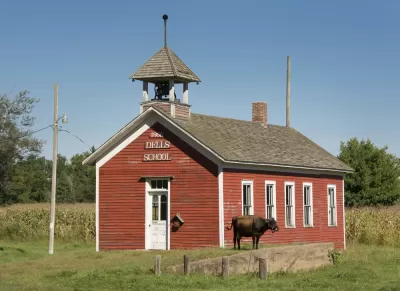Wisconsin provides a case study in the varied methods for defining rural, and why that matters. "Rural is not simple to define, perhaps because the real question is rural for what purpose?"

"It's a matter of conventional wisdom in Wisconsin and across the U.S. that rural places are socially and culturally different from urban and suburban areas," writes Malia Jones. "But it's helpful to examine how rurality is officially defined to explore its many dimensions."
Jones notes that demographers and social geographers use several methods to identify areas as rural, and demographers define rural areas as anything that "not urban." With Wisconsin offering examples to illustrate her points, Jones walks through the definitions used by the U.S. Census Bureau, the U.S. Office of Management and Budget, and the U.S. Department of Agriculture. The state of Wisconsin also employs metrics that complicate the task of defining what is and what is not rural.
FULL STORY: Putting Rural Wisconsin On The Map

Study: Maui’s Plan to Convert Vacation Rentals to Long-Term Housing Could Cause Nearly $1 Billion Economic Loss
The plan would reduce visitor accommodation by 25,% resulting in 1,900 jobs lost.

North Texas Transit Leaders Tout Benefits of TOD for Growing Region
At a summit focused on transit-oriented development, policymakers discussed how North Texas’ expanded light rail system can serve as a tool for economic growth.

Why Should We Subsidize Public Transportation?
Many public transit agencies face financial stress due to rising costs, declining fare revenue, and declining subsidies. Transit advocates must provide a strong business case for increasing public transit funding.

How to Make US Trains Faster
Changes to boarding platforms and a switch to electric trains could improve U.S. passenger rail service without the added cost of high-speed rail.

Columbia’s Revitalized ‘Loop’ Is a Hub for Local Entrepreneurs
A focus on small businesses is helping a commercial corridor in Columbia, Missouri thrive.

Invasive Insect Threatens Minnesota’s Ash Forests
The Emerald Ash Borer is a rapidly spreading invasive pest threatening Minnesota’s ash trees, and homeowners are encouraged to plant diverse replacement species, avoid moving ash firewood, and monitor for signs of infestation.
Urban Design for Planners 1: Software Tools
This six-course series explores essential urban design concepts using open source software and equips planners with the tools they need to participate fully in the urban design process.
Planning for Universal Design
Learn the tools for implementing Universal Design in planning regulations.
Ascent Environmental
Borough of Carlisle
Institute for Housing and Urban Development Studies (IHS)
City of Grandview
Harvard GSD Executive Education
Toledo-Lucas County Plan Commissions
Salt Lake City
NYU Wagner Graduate School of Public Service





























